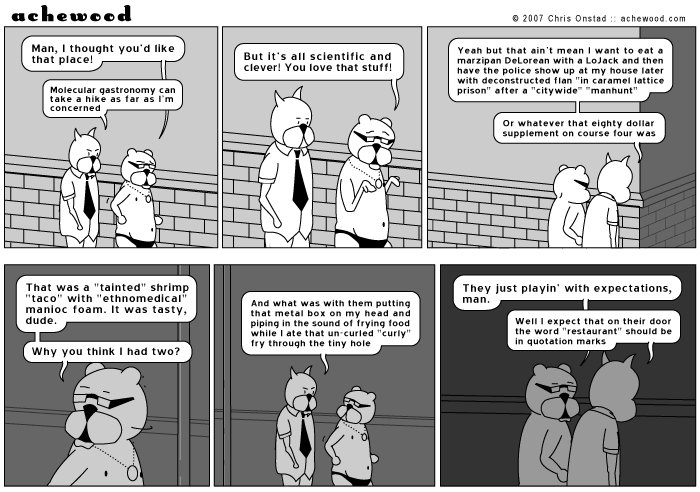
“Two nights later, I went to the new restaurant down from them and chased bits of bloody caribou in blueberry cocoa sauce around a platter. And foam. The foam trend began with carrots at El Bulli in Spain. I had tomato foam in Paris two years ago, after a four-kilometre hike on a hot day, and I remember it with a shudder. How expensively unsatisfying is foam. Now foam is foaming. Some things shouldn’t be foamed — mustard, beetroot, leotards, kraft paper envelopes. I’ve had it with foam. Cease this.” – Heather Mallick, March 2, 2007, Rabble News
“Eye Weekly’s own Alan A. Vernon has a theory as to why the city’s fine restaurants just can’t seem to get their molecules oscillating. “It’s too intimidating to Toronto foodies,” Vernon says. “Very few people are daring to base a menu around molecular gastronomy, and the ones that do end up dumbing it down, because if the less sophisticated come in and think they’re being served a science project, they aren’t coming back. So it’s a business decision.”
The only aspect of this futuristic fare that seems to have had any popularity in the city is food foam — molecular gastronomy’s most infamous creation. Adria is rumoured to have discovered this light as air “food,” which requires a thickening ingredient such as gelatin or xanthan gum, a flavoured liquid and a whipped-cream dispenser or high-tech foamer powered by nitrous oxide canisters, almost by accident. Depending who you talk to, his discovery was either an act of divine intervention or the work of the devil himself.” – Meghan Eves, March 15, 2007, Eye Weekly
“We need more of Cooking 101 before going into molecular gastronomy. So many people are going into it without knowing how to actually cook, so it may look good, but it’s not tasty.” – Morou Ouattara, chef-owner, Farrah Olivia in Alexandria, VA
“We need less… molecular gastronomy in the hands of amateurs who don’t know how to use it..” – Robert Gadsby, chef, Noé in LA and Houston, among others
“Historically, when women move into men’s work it loses value,” she said. “Maybe we’ll see the pay drop, and the science suddenly getting called ‘soft.’ I’ll say this: If you see me doing foams at Prune, you’ll know the whole thing has gone down the tube.” – Gabrielle Hamilton, owner/chef, Prune
“The guiding principle is to create dishes based on the molecular compatibilities of foods. For instance, unripe mango and pine share a molecular structure, so they might be tasty if combined. That’s the theory, anyway. Molecular gastronomists combine white chocolate and oysters for the same reason. Geek gourmet began with experiments by professional chefs at high-end restaurants like El Bulli in Spain and the Fat Duck in England, where steam baths, centrifuges and microscopes share counter space with more traditional cooking tools.” – Xeni Jardin, National Public Radio
“The ideal customer doesn’t come to El Bulli to eat,” Adrià has declared, “but to have an experience,” inadvertently revealing not just the purpose of the operation, but also that there is an ideal customer, which may very well not be you, who merely wanted to eat. The fact that eating is rather low down the priority list of molecular cooking is evidenced not just by the proliferation of foams and froths, crumbs and powders, but by the global obsession with serving a multiplicity of tiny courses, for which the inaccurate analogy is usually Spanish tapas.” – Stuart Walton, The World of Fine Wine Magazine
